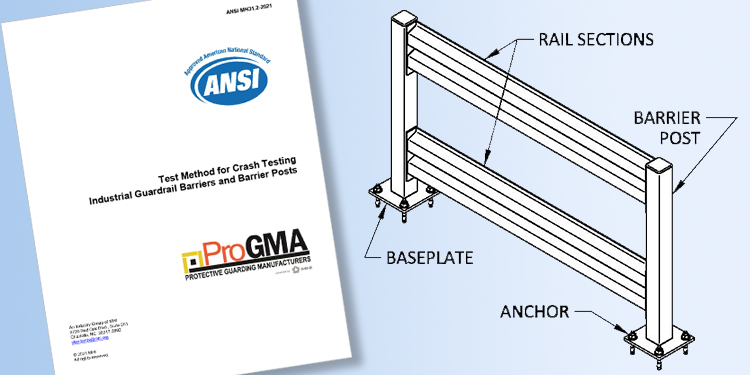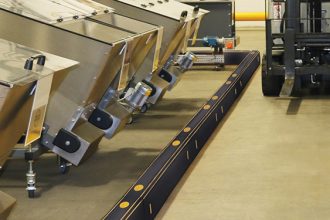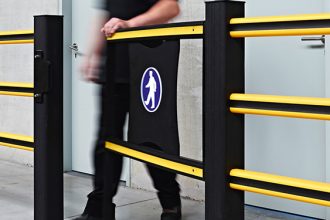New Standard for Crash Testing Industrial Guardrails and Barriers Used in Warehousing Applications Released

Industrial guardrail barriers and barrier posts are frequently utilized within industrial and warehouse environments to safeguard against impacts by motorized vehicles, such as forklifts. Typically, these barriers — which include bollards, industrial facility protection guardrail, and industrial pedestrian guardrail — are floor-mounted directly on ground-level concrete with robust anchors. Their purpose is to protect pedestrians in designated walkways, critical equipment, rack structures, automated machinery, and facility features (such as columns, corners, walls, electrical or ventilation equipment and more). Ultimately, the use of guardrails and barriers safeguards personnel, products, and property.
To help owners, users, designers, purchasers, or specifiers of these types of products, the members of the Protective Guarding Manufacturers Association (ProGMA), recently published a new standard, “ANSI MHI31.2-2021 – Test Method for Crash Testing Industrial Guardrail Barriers and Barrier Posts,” available for purchase. The standard was developed because ProGMA recognized a need to standardize performance and design criteria for the proper utilization of industrial guardrail and post systems. Prior to its publication, no standardized test method had been established to assess the crash performance of these protective devices. That made it difficult for potential purchasers to compare various product options.
The ANSI MHI31.2 standard represents testing practices and performance criteria that may be used in determining product utilization. It outlines a test method that provides a variety of selection options for both gross vehicle weight and impact speed which are predetermined prior to testing. A surrogate test vehicle, designed to simulate a powered industrial truck of similar weight, is then driven to the chosen speed just prior to impact.
Maximum dynamic penetration distance is recorded for each test and serves as the primary measure of overall test performance. Depending on the material used in the construction of the guardrail — typically steel or polymer — the device will respond in one of two ways: steel will bend as it deflects the impact but will not return to its previous shape; polymer will flex to deflect the impact but will return to its previous shape.
The amount of penetration distance is dependent on the type of material used. Generally, a flexible guardrail barrier will deflect further due to an impact than a steel guardrail barrier will. Based on the guardrail material’s behavior, the barrier’s optimal installation position can be determined such that — in the event of an impact — it does not make contact with the object or area it is intended to protect.
The standard calls for the testing to be performed at an ISO/IEC 17025 accredited testing facility. To determine the impact rating designation of a specific product, the test is set up to meet a specific gross vehicle weight (ranging from 9,000 pounds to 20,000 pounds) traveling at one of three nominal impact speeds: 3.0, 5.0 or 7.0 miles per hour. Based on the findings, a purchaser can determine what degree of impact protection a specific barrier will provide based on the speed the vehicle was traveling prior to impact, as well as how far the protective guardrail or barrier should be positioned away from the protected item so as to avoid contact.
Thinking of protective guardrails and barriers in your operation? Learn how to identify where in your facility they may be needed, here.



